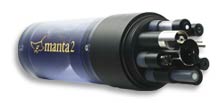River Monitoring for Renewable Energy Source
Abstract
Located along the Scottish border a 48 strong wind turbine development is under construction. To ensure minimal disturbance to the natural surroundings and to protect the local rivers RS Hydro were commissioned to provide a real-time water quality monitoring system to assess any impacts from the construction.
Equipment Used
Manta 2
Background
Fallago Rig is the site for the new 48 turbine wind farm which is set to produce 144 MW of renewable electricity. Commissioned and installed by North British Wind Power this large scale operation has been closely watched for environmental impact and local development.
With three rivers within the catchment, it is imperative that there are no environmental impacts associated with the construction project and therefore safeguarding the surrounding landscape and habitat. Monitoring pH, ORP (Redox), Turbidity, Conductivity and Dissolved Oxygen using the Eureka Manta multi-parameter sonde gives a perfect indication of point source pollution, such as concrete, soil and other construction waste material. Furthermore by comparing the water quality readings of the upstream and downstream sondes in near real-time it is posisble to provide a definitive indication as to whether the construction has caused any changes in water quality.
The Solution
 Locally downloading these devices would be too labour intensive and so required the use of a wireless telemetry system. The locations are extremely remote with no GSM or GPRS coverage from any provider. As such, RS Hydro used the Adcon RA440 GPRS-UHF wireless telemetry bridge to provide a real-time connection to site. The GPRS base station reconverts GPRS transmission data into local UHF (up to 20km range in one hop). Due to the rugged terrain, it was not possible to talk to the wireless telemetry loggers in one hop and therefore two A731 wireless telemetry relays were used to provide a hop. These are typically located to extend the line of sight range. Due to the presence of significant hills, two relays were located in such a way to 'look around' the hills to provide an extended line of sight. Adding relays or intermediate monitoring stations to a network only reduces data transfer by a second or two at most. Therefore it is possible to have very extensive networks monitoring in almost real-time.
Locally downloading these devices would be too labour intensive and so required the use of a wireless telemetry system. The locations are extremely remote with no GSM or GPRS coverage from any provider. As such, RS Hydro used the Adcon RA440 GPRS-UHF wireless telemetry bridge to provide a real-time connection to site. The GPRS base station reconverts GPRS transmission data into local UHF (up to 20km range in one hop). Due to the rugged terrain, it was not possible to talk to the wireless telemetry loggers in one hop and therefore two A731 wireless telemetry relays were used to provide a hop. These are typically located to extend the line of sight range. Due to the presence of significant hills, two relays were located in such a way to 'look around' the hills to provide an extended line of sight. Adding relays or intermediate monitoring stations to a network only reduces data transfer by a second or two at most. Therefore it is possible to have very extensive networks monitoring in almost real-time.
At the monitoring locations, two addIT A723 UHF RTUs were used to provide power for the Manta2 sondes using micro-sized solar panels (15x15cms!) and to interrogate the sondes for data every 15 minutes. The A723 UHF telemetry RTU has a 40-channel SDI12/modbus port to scan up to 40 sensors at any one time which means that we could have installed up to 5-6 sondes all on one radio, and perhaps a weather station for good measure! Furthermore it would also be possible (and without modifications) to add an auto-sampler which could be triggered remotely or locally without any additional hardware. No kiosks were needed and hence reduced the cost of the installation. The RTUs and solar panels were quickly and securely attached to a rigid pole, whilst the sondes were installed in stilling wells adjacent to the river bank.
As with all environmental monitoring, power is often a significant challenge. No mains power is available and large battery banks, kiosks and solar panel arrays are not only expensive but visually intrusive. The Adcon solution is so energy efficient and advanced that it can minimise power consumption.
 This total solution therefore provides a real-time warning system for this project. Maintenance is simply reduced to the routine calibration of the sensors. The client can therefore have reliable up to date information about the water quality of the surrounding streams without having to utilise significant resources to change batteries, download data or worry whether the system is working. This monitoring system does all this automatically.
This total solution therefore provides a real-time warning system for this project. Maintenance is simply reduced to the routine calibration of the sensors. The client can therefore have reliable up to date information about the water quality of the surrounding streams without having to utilise significant resources to change batteries, download data or worry whether the system is working. This monitoring system does all this automatically.
